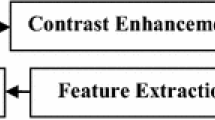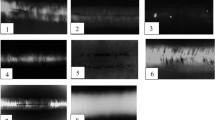Abstract
Several factors such as low image quality, limited human eye resolution, and biased interpretation make the manual radiography testing defect detection erroneous. The aim of this paper is to design a semi-automatic but accurate feature extraction and classification framework, using radiography images of welded joints represented in the GDXray image database. We have trained our support-vector machine classifier with crack, porosity and lack of penetration as the three more frequent classes of radiography defects. The images are segmented after binarization followed by a two-stage image enhancement technique. The body of the two-stage method is made up of an anisotropic diffusion Gaussian filtering, morphological edge detection, and low-pass Gaussian filtering. A three-class support-vector machine based on One-vs.-All implementation of the binary support-vector machine is created, trained, and tested. The method also involves manual adjustments which makes it semi-automatic, and compared to other studies, it is proved to work best with GDXray, a freely available comprehensive radiography image database. The effect of incorporating different optimization algorithms for solving the inherent optimization problem in support-vector machine theory, and utilizing various image processing techniques on defect detection is studied. We show that the combination of image processing and support-vector machine would result in a better performance than the previous studies using the same database.









Similar content being viewed by others
REFERENCES
Mery, D., X-ray testing by computer vision, Proc. 2013 IEEE Conf. on Computer Vision and Pattern Recognition Workshops (CVPRW'13), Washington, DC: IEEE Comput. Soc., 2013.
Shirai, Y., Automatic inspection of x-ray photograph of welding, Pattern Recognit., 1969, vol. 1, no. 4, pp. 257–261.
Roberts, E., Real-Time Radiographic Inspection Facility, Washington, DC: Natl. Aeronaut. Space Admin., 1977.
Mery, D., Jaeger, T., and Dieter, F., A review of methods for automated recognition of casting defects, Insight (Northampton, UK), 2002, vol. 44, no. 10, pp. 614–615.
Kehoe, A. and Parker, G.A., An intelligent knowledge-based approach for the automated radiographic inspection of castings, NDT&E Int., 1992, vol. 25, no. 1, pp. 23–36.
Liao, T.W., Li, D., and Li, Y., Detection of welding flaws from radiographic images with fuzzy clustering methods, Fuzzy Sets Syst., 1999, vol. 108, no. 2, pp. 145–158.
Lashkia, V., Defect detection in X-ray images using fuzzy reasoning, NDT&E Int., 2001, vol. 19, no. 5, pp. 261–269.
Wang, G. and Liao, T.W., Automatic identification of different types of welding defects in radiographic images, NDT&E Int., 2002, vol. 35, no. 8, pp. 519–528.
Mirapeix, J.Ã., Garcı, P.B., Cobo, A., Conde, O.M., and Lo, J.M., Real-time arc-welding defect detection and classification with principal component analysis and artificial neural networks, NDT&E Int., 2007, vol. 40, pp. 315–323.
Da Silva, R.R., Siqueira, M.H.S., De Souza, M.P.V., Rebello, J.M.A., and Calôba, L.P., Estimated accuracy of classification of defects detected in welded joints by radiographic tests, NDT&E Int., 2005, vol. 38, no. 5, pp. 335–343.
Sun, Z., Kaucic, R., Can, A., and Mendonça, P.R.S., A statistical approach to industrial anomaly detection, Proc. 10th European Conf. on Non-Destructive Testing (ECNDT 2010), Moscow, 2010, pp. 1–9.
Lockard, C.D., Anomaly detection in radiographic images of composite materials via crosshatch regression, MSc Thesis, Ann Arbor, MI: Mills College, 2015.
Xiao, X., Automated defect recognition in digital radiography, PhD Thesis, Cincinnati, OH: Univ. of Cincinnati, 2015.
Wang, Y. and Guo, H., Weld defect detection of X-ray images based on support vector machine, IETE Tech. Rev., 2014, vol. 31, no. 2, pp. 137–142.
Mekhalfa, F. and Nacereddine, N., Multiclass classification of weld defects in radiographic images based on support vector machines, Proc. 2014 Tenth Int. Conf. on Signal-Image Technology and Internet-Based Systems, Piscataway, NJ: Inst. Electr. Electron. Eng., 2014.
Mery, D. and Arteta, C., Automatic defect recognition in X-ray testing using computer vision, Proc. 2017 IEEE Winter Conf. on Applications of Computer Vision (WACV), Piscataway, NJ: Inst. Electr. Electron. Eng., 2017, pp. 1026–1035.
Mery, D., et al., “GDXray: The database of X-ray images for nondestructive testing, J. Nondestr. Eval., 2015, vol. 34, no. 4, pp. 1–12.
ISO 14096-2:2005: Non-Destructive Testing—Qualification of Radiographic Film Digitization Systems, Geneva: Int. Stand. Org., 2005.
Mirzaei, F., Parishan, M.R., Faridafshin, M., Faghihi, R., and Sina, S., Automated brain tumor segmentation in MR images using a hidden Markov classifier framework trained by SVD-derived features, EURASIP J. Image Video Process., 2018, vol. 9, no. 1, pp. 1844–1848.
Alvarez, L. and Mazorra, L., Signal and image restoration using shock filters and anisotropic diffusion, SIAM J. Numer. Anal., 1994, vol. 31, no. 2, pp. 490–605.
Getreuer, P., A survey of Gaussian convolution algorithms, Image Process. On Line, 2013, vol. 3, pp. 286–310.
Faridafshin, J., Movafeghi, A., and Faghihi, R., Multiclass detection of radiographic defects in welded joints usingtwo-stage image enhancement and support vector machine, Proc. 12th European Conf. on Non-Destructive Testing (ECNDT 2018), Gothenburg, 2018.
Dung, L., Sun, S., and Wu, Y., Implementation of shock filter for digital x-ray image processing, J. Comput. Commun., 2014, vol. 2, pp. 25–33.
Mirzaei, F., Faridafshin, M., Movafeghi, A., and Faghihi, R., Automated defect detection of weldments and castings using Canny, Sobel and Gaussian filter edge detectors: A comparison study, Proc. 4th Iranian Int. NDT Conf. “Iran NDT 2017,” Tehran, 2017.
Weickert, J., Coherence-enhancing shock filters, Proc. 25th DAGM Symp. Pattern Recognition, Magdeburg, Germany, September 10–12, 2003, Berlin: Springer, 2003, pp. 1–8.
Bouaynaya, N. and Schonfeld, D., Spatially variant morphological image processing: Theory and applications, Proc. SPIE, 2006, vol. 6077.
Zhao, Y.-Q., Gui, W.-H., Chen, Z.-C., Tang, J.-T., and Li, L.-Y., Medical images edge detection based on mathematical morphology, Proc. 2005 IEEE Engineering in Medicine and Biology 27th Annual Conf., Piscataway, NJ: Inst. Electr. Electron. Eng., 2006, vol. 6, pp. 6492–6495.
Heijmans, H.J. and Ronse, C., The algebraic basis of mathematical morphology I. Dilations and erosions, Comput. Vision, Graph. Image Process., 1990, vol. 50, no. 3, pp. 245–295.
Lee, J.S.J., Haralick, R.M., and Shapiro, L.G., Morphologic edge detection, IEEE J. Rob. Autom., 1987, vol. 3, no. 2, pp. 142–156.
Sezgin, M. and Snakur, B., Survey over image thresholding techniques and quantitative performance evaluation, J. Electron. Imaging, 2004, vol. 13, no. 1, pp. 146–165.
Nacereddine, N., Tridi, M., Hamami, L., and Ziou, D., Statistical tools for weld defect evaluation in radiographic testing, Proc. 9th European Conf. on NDT, Berlin, Brussels: Eur. Fed. Nondestr. Test., 2006, pp. 1–21.
Otsu, N., A threshold selection method from gray-level histograms, Automatica, 1975, vol. 11, nos. 285–296, pp. 23–27.
Aquino, A., Gegúndez-Arias, M.E., and Marín, D., Detecting the optic disc boundary in digital fundus images using morphological, edge detection, and feature extraction techniques, IEEE Trans. Med. Imaging, 2010, vol. 29, no. 11, pp. 1860–1869.
Baniukiewicz, P., Automated defect recognition and identification in digital radiography, J. Nondestr. Eval., 2014, vol. 33, no. 3, pp. 327–334.
Mustapha, S., Braytee, A., and Ye, L., Multi-source data fusion for classification of surface cracks in steel pipes, J. Nondestr. Eval., Diagn. Prognostics Eng. Syst., 2018, vol. 1, no. 2, art. ID 021007.
Burges, C.J.C., A tutorial on support vector machines for pattern recognition, Data Min. Knowl. Discovery, 1998, vol. 2, no. 2, pp. 121–167.
Auria, L. and Moro, R.A., Support Vector Machines (SVM) as a Technique for Solvency Analysis, Berlin: German Inst. Econ. Res., 2008.
Shen, Q., Gao, J., and Li, C., Automatic classification of weld defects in radiographic images, Insight (Northampton, UK), 2010, vol. 52, no. 3, pp. 134–139.
Kutin, S. and Niyogit, P., Almost-Everywhere Algorithmic Stability and Generalization Error: Technical Report TR-2002-03, Chicago: Univ. of Chicago, 2002.
Xu, H., Caramanis, C., and Mannor, S., Robustness and regularization of support vector machines, J. Mach. Learn. Res., 2009, vol. 10, pp. 1485–1510.
Gretton, A., Introduction to RKHS, and some simple kernel algorithms, 2014. https://citeseerx.ist.psu.edu/ viewdoc/download?doi=10.1.1.705.292&rep=rep1&type=pdf.
Narsky, I. and Porter, F.C., Multiclass extensions of support vector machines, in Statistical Analysis Techniques in Particle Physics: Fits, Density Estimation and Supervised Learning, Chichester: Wiley, 2013, pp. 3–7.
Rifkin, R. and Klautau, A., In defense of one-vs-all classification, J. Mach. Learn. Res., 2004, vol. 5, pp. 101–141.
James, G., Witten, D., Hastie, T., and Tibshirani, R., An Introduction to Statistical Learning with Applications in R, New York: Springer, 2017, 7th ed.
Jain, V., Bollmann, B., Richardson, M., et al., Boundary learning by optimization with topological constraints supplementary material, Proc. 2010 IEEE Computer Society Conf. on Computer Vision and Pattern Recognition, Piscataway, NJ: Inst. Electr. Electron. Eng., 2010, pp. 2488–2495.
Gonzalez, R.C., Woods, R.E., and Hall, P., Digital Image Processing, Upper Saddle River, NJ: Prentice Hall, 2004, 2nd ed.
Geletu, A., Solving Optimization Problems using the Matlab Optimization Toolbox: A Tutorial, Ilmenau: Tech. Unive. Ilmenau, 2007.
Schölkopf, B. and Smola, A.J., Learning with Kernels: Support Vector Machines, Regularization, Optimization, and Beyond, Cambridge, MA: MIT Press, 2002.
Hou, W., Wei, Y., Jin, Y., and Zhu, C., Deep features based on a DCNN model for classifying imbalanced weld flaw types, Measurement, 2019, vol. 131, pp. 482–489.
Author information
Authors and Affiliations
Corresponding authors
Rights and permissions
About this article
Cite this article
Reza Faghihi, Faridafshin, M. & Movafeghi, A. Patch-Based Weld Defect Segmentation and Classification Using Anisotropic Diffusion Image Enhancement Combined with Support-Vector Machine. Russ J Nondestruct Test 57, 61–71 (2021). https://doi.org/10.1134/S1061830921300021
Received:
Revised:
Accepted:
Published:
Issue Date:
DOI: https://doi.org/10.1134/S1061830921300021




